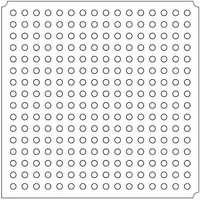LFXP2-5E-5FTN256I Lattice, LFXP2-5E-5FTN256I Datasheet - Page 298

LFXP2-5E-5FTN256I
Manufacturer Part Number
LFXP2-5E-5FTN256I
Description
FPGA - Field Programmable Gate Array 5K LUTs 172 I/O Inst on DSP 1.2V -5 Spd
Manufacturer
Lattice
Datasheet
1.LFXP2-8E-5FTN256I.pdf
(341 pages)
Specifications of LFXP2-5E-5FTN256I
Number Of Macrocells
5000
Number Of Programmable I/os
172
Data Ram Size
169984
Supply Voltage (max)
1.26 V
Maximum Operating Temperature
+ 100 C
Minimum Operating Temperature
- 40 C
Mounting Style
SMD/SMT
Supply Voltage (min)
1.14 V
Package / Case
FTBGA-256
Number Of Logic Elements/cells
*
Number Of Labs/clbs
*
Total Ram Bits
169984
Number Of I /o
172
Number Of Gates
-
Voltage - Supply
1.14 V ~ 1.26 V
Mounting Type
*
Operating Temperature
-40°C ~ 100°C
Lead Free Status / RoHS Status
Lead free / RoHS Compliant
Available stocks
Company
Part Number
Manufacturer
Quantity
Price
Company:
Part Number:
LFXP2-5E-5FTN256I
Manufacturer:
Lattice
Quantity:
135
Company:
Part Number:
LFXP2-5E-5FTN256I
Manufacturer:
LATTICE
Quantity:
23
Company:
Part Number:
LFXP2-5E-5FTN256I
Manufacturer:
Lattice Semiconductor Corporation
Quantity:
10 000
Part Number:
LFXP2-5E-5FTN256I
Manufacturer:
LATTICE
Quantity:
20 000
- Current page: 298 of 341
- Download datasheet (10Mb)
Lattice Semiconductor
Slave SPI Mode Operation
The Slave SPI Mode interface to the TAG memory supports both SPI Bus Mode 0 and Mode 3 operations. In SPI
Bus Mode 0 the CLK pin is normally low when the SPI master is in standby and data is not being transmitted. In
SPI Bus Mode 3 the CLK pin is normally high during this condition. In both cases the data at the SISPI pin is sam-
pled on the rising edge of CCLK and the data output on the SOSPI pin is clocked on the falling edge of CCLK.
For more information on using the TAG memory please see TN1137,
User Flash
The User Flash is designed as a non-volatile memory location to back up the data stored in the EBR RAM blocks.
This gives the user a reliable method to save the contents of the RAM memory for later use.
The amount of User Flash for LatticeXP2 devices is directly tied to the number of EBR blocks in the device and it
scales with density. The User Flash is organized physically as either 1- or 2- separate User Flash Modules. How-
ever, all User Flash Modules are logically treated as one unified block.
Table 14-11. User Flash Organization
The EBR blocks act as the primary interface for the User Flash. Users do not have direct access to the User Flash.
The contents of the EBR can be saved into the User Flash via a store-to-flash control signal. The EBR contents
must be saved into the User Flash when required. Two signals, UFMFAIL and UFMBUSYN are provided for keep-
ing track of the status of the store-to-flash command. If the UFMFAIL signal is low and the UFMBUSYN signal is
high then the EBR contents were successfully stored in the Flash memory.
The User Flash memory has the following constraints upon its usage.
• The Store-to-Flash operation has impact only on the EBR RAM (Single-Port, True Dual-Port, Pseudo Dual-Port)
• During the Store-to-Flash operation, the EBR blocks are unavailable for user operation and the Flash is unavail-
• No selective EBR storing is supported. A Store-to-Flash operation will store the contents of all EBR blocks.
• Due to silicon limitations the user cannot use Store-to-Flash operation if the SED is operating in an Always mode.
• UFM mode cannot concurrently be used with Transparent/Background mode (Flash or SRAM). The SSPI config-
Table 14-12. Differences Between User Flash and Shadow Flash (EBR) Behavior
For more information, please see TN1137,
configurations.
able for configuration operation.
uration and verify operations (which are essentially Transparent Mode operations) are initiated by the user and
the user needs to ensure that the UFM operation is not requested at the same time.
Physical UFM blocks
Logical UFM blocks
Read/write access speed
Access nature
Data access
Data organization
Data granularity
Block Type
Parameter
XP2-5K
1
1
Sequential
Slow
Limited (refer to Sec13.3)
Sequential, one bit at a time
Whole UFM block
LatticeXP2 Memory Usage
XP2-8K
User Flash
1
1
14-16
XP2-17K
LatticeXP2 sysCONFIG Usage Guide
LatticeXP2 Memory Usage
2
1
Guide.
Fast
Random
Infinite or unlimited
Flexible, variable data width
One EBR block
Shadow Flash (EBR)
XP2-30K
2
1
Guide.
XP2-40K
2
1
Related parts for LFXP2-5E-5FTN256I
Image
Part Number
Description
Manufacturer
Datasheet
Request
R

Part Number:
Description:
FPGA - Field Programmable Gate Array 5K LUTs 146I/O Inst- on DSP 1.2V -5 Spd
Manufacturer:
Lattice
Datasheet:

Part Number:
Description:
FPGA - Field Programmable Gate Array 5K LUTs 172I/O Inst- on DSP 1.2V -5 Spd
Manufacturer:
Lattice
Datasheet:

Part Number:
Description:
FPGA - Field Programmable Gate Array 5K LUTs 100 I/O Inst on DSP 1.2V -5 Spd
Manufacturer:
Lattice
Datasheet:

Part Number:
Description:
FPGA - Field Programmable Gate Array 5K LUTs 100I/O Inst- on DSP 1.2V -5 Spd
Manufacturer:
Lattice
Datasheet:
Part Number:
Description:
FPGA LatticeXP2 Family 5000 Cells Flash Technology 1.2V 256-Pin FTBGA
Manufacturer:
LATTICE SEMICONDUCTOR
Datasheet:
Part Number:
Description:
FPGA LatticeXP2 Family 5000 Cells Flash Technology 1.2V 256-Pin FTBGA
Manufacturer:
LATTICE SEMICONDUCTOR
Datasheet:

Part Number:
Description:
IC DSP 5KLUTS 100I/O 144TQFP
Manufacturer:
Lattice
Datasheet:

Part Number:
Description:
IC DSP 5KLUTS 86I/O 132CSBGA
Manufacturer:
Lattice
Datasheet:

Part Number:
Description:
IC DSP 5KLUTS 86I/O 132CSBGA
Manufacturer:
Lattice
Datasheet:

Part Number:
Description:
IC DSP 5KLUTS 146I/O 208PQFP
Manufacturer:
Lattice
Datasheet:

Part Number:
Description:
IC DSP 5KLUTS 146I/O 208PQFP
Manufacturer:
Lattice
Datasheet:

Part Number:
Description:
IC DSP 5KLUTS 172I/O 256FTBGA
Manufacturer:
Lattice
Datasheet:

Part Number:
Description:
IC FPGA 5KLUTS 86I/O 132-BGA
Manufacturer:
Lattice
Datasheet:

Part Number:
Description:
IC FPGA 5KLUTS 86I/O 132-BGA
Manufacturer:
Lattice
Datasheet:

Part Number:
Description:
IC FPGA 5KLUTS 86I/O 132-BGA
Manufacturer:
Lattice
Datasheet:











